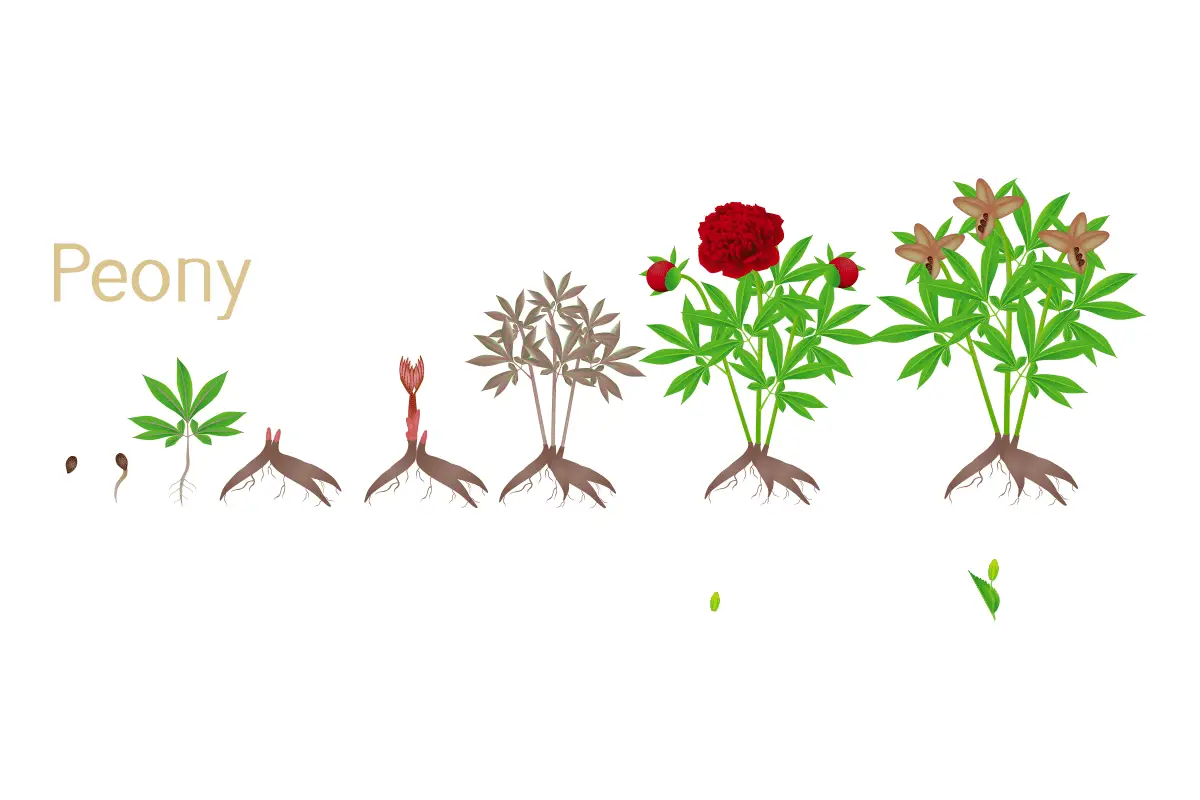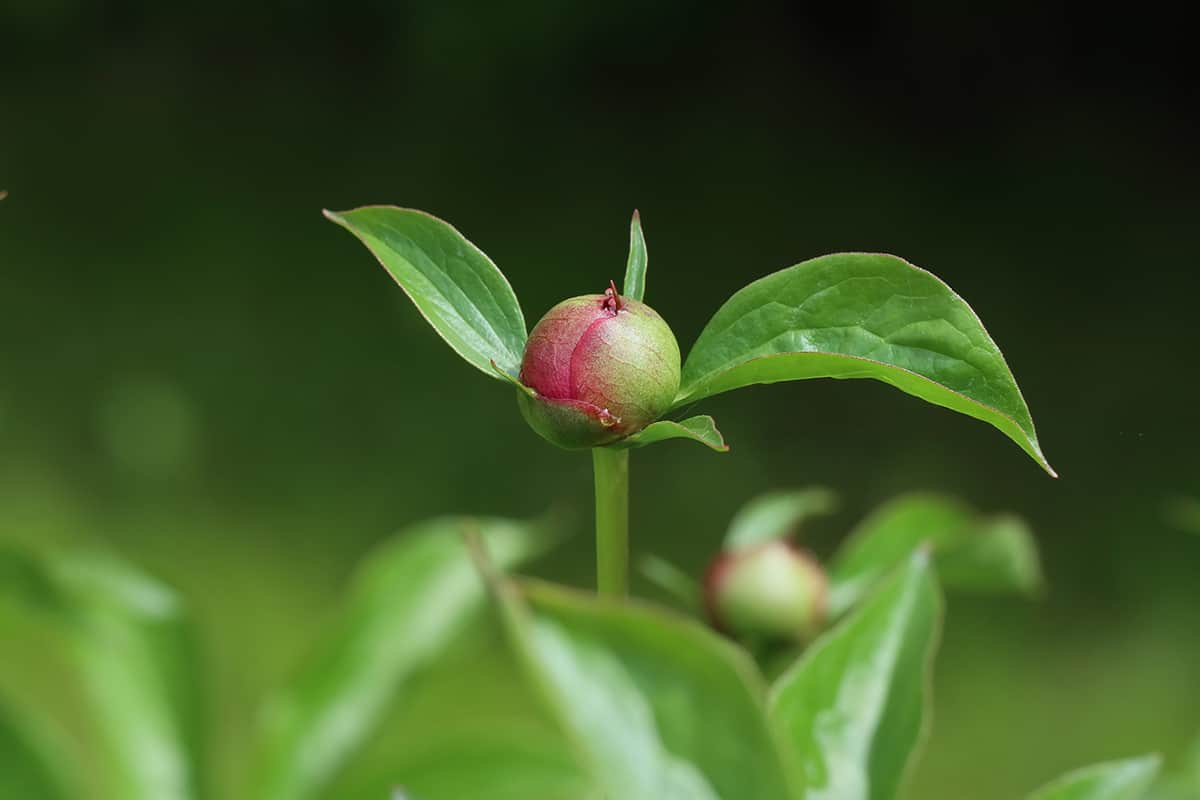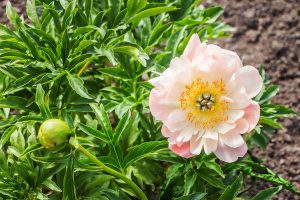Peonies are herbaceous perennials, which means that they die back each fall and reappear each spring. They repeat this process each year so that every year the plant will go through the same processes of growth, blooming, and rest.
Each growth stage is essential to the plant so that it is able to continue repeating the cycle and producing flowers and foliage year on year. Here we take a closer look at the growth stages of peonies.
Table of Contents
Young Peony Growth Stages

When you purchase a young peony plant from a local nursery or an online plant store, the peony will usually be around 4 or 5 years old. The nursery will have nurtured the plant to the point that the root system is well established, enabling you to plant it in your garden and have a high chance of success for the peony to bloom the next season.
Rest Stage
The recommended transplanting time for young peonies is in the fall since this is when they will enter a period of rest. This allows the root system time to adapt to its new home and establish itself before it will enter a period of rapid growth next spring, and is subjected to higher levels of light and heat. During the period of rest, any parts of the plant which are above ground will die back.
Rather than have a border filled with dead foliage, you can keep the area looking clean by cutting the stems of the plant back to ground level. This can also help to lower the incidence of disease and pest problems. While above ground, it may look as though your peony has bitten the dust, beneath the soil, the roots will be resting and storing nutrients ready for their time in the spotlight the following spring.
If your peony has recently been planted, it will use this period of rest to recover from being transplanted since peonies don’t like to have their roots disturbed. Peonies that are already well established in the soil will go dormant throughout their period of rest in preparation for their period of growth.
You can help your peony plants during their period of rest by mulching over the soil as a means of insulation. Since peonies are planted in the shallow depths of the soil, their roots could freeze if not protected. A thick layer of mulch will help to ensure the roots near the surface of the soil won’t get too cold.
In warm climates, you won’t need to mulch your soil in winter, as actually, this can be detrimental to the rest phase of the peony. Peonies need to be subjected to a period of at least three months of consistently low temperatures, and in warm climates, this may not happen if the soil has been mulched over.
Plant Growth Stage
You should start to notice shoots breaking through the surface of the soil in April. This is an indication that the peony plant has emerged from its period of rest and is now entering the growth stage. If you mulch over your peonies for winter, you can now remove this mulch to create space for the peony bushes to grow.
This is also a good time to apply fertilizer to give the peonies an extra boost of nutrients in preparation for flowering. Throughout this period of growth, the peony will expand vigorously, gaining several inches of height and spread each week. Most herbaceous peonies will reach between 2 and 3 feet in either direction in the space of around 4 to 6 weeks.
While developing a compact bush of lush, green, and glossy foliage, the plant will also start to send out thick, erect stems. These are what the flowers will be held on.
Blooming Stage
The next stage of growth for the peony plant is blooming. This is when buds will appear on the stems of the plant. The buds will typically get to around the size of a golf ball before they start to open out into dramatic flowers. When the buds open out, the true color of the petals will become visible, and each flower will remain in bloom for a minimum of 7 days, or longer depending on the cultivar and the conditions.
The time of year the peonies enter their blooming stage will also vary according to the cultivar and local climate. Peony plants will either be early-season bloomers, mid-season bloomers, or late-season bloomers. If you have an early-season bloomer these will flower at the end of spring, either in late April or more commonly in early May. Mid-season bloomers will appear in mid to late May, while late-season bloomers will not bloom until June.
After the plant has bloomed, you should deadhead the spent flowers, unless you plan to harvest the seed pods to grow new peony plants. When the peonies’ flowers have died, seed pods will develop, but this requires significant energy. If you don’t intend to use the seed pods, then deadheading the flowers will be beneficial to the health of the plant, since the energy, it would have used developing seed pods can instead be stored and saved for future use in developing a strong root system, or foliage and flower growth.
The leaves of the plant will remain attractive throughout the rest of summer after the plant has bloomed. The foliage often warms up to autumnal shades in the fall, before it dies back to the ground. By September or October, the peony plant will have completed one round of its life cycle, having gone through all of the growth stages. It will then enter a period of rest, and start its growth cycle all over again.
Peony Seed Growth Stages

If you are growing a peony from seed then the growth stages described above will be preceded by the stages the seed goes through in order to germinate.
Seed Stage
Peony seeds which are fresh and pale in color are ready to plant immediately, while those with a dark shell have a hard outer layer that needs to be broken down before it can be planted. You can do this by filing down the side of the shell, or soaking it in water every day for around a week. Once you have the pale inner seed, it can be planted in shallow, moist soil. At this stage, the seed holds the potential of what the peony plant could be.
Root Development Stage
If your local climate is still quite warm in fall, then some roots may develop from the seed before it enters its period of dormancy. Otherwise, roots will not develop until the ground has thawed the following spring.
Germination Stage
Once roots have sprouted from the seed, you will begin to see the emergence of sprouts above ground shortly after. From a distance, the shoots will appear as slender stems, though if you look more closely, you will see the unfurled leaves are contained in the shoots.
These will soon open out, and the peony can begin its life cycle as described above, starting with its plant growth stage before moving to blooming, resting, and repeating. When growing a peony from seed your plant may not go through the blooming stage until it is several years old.






